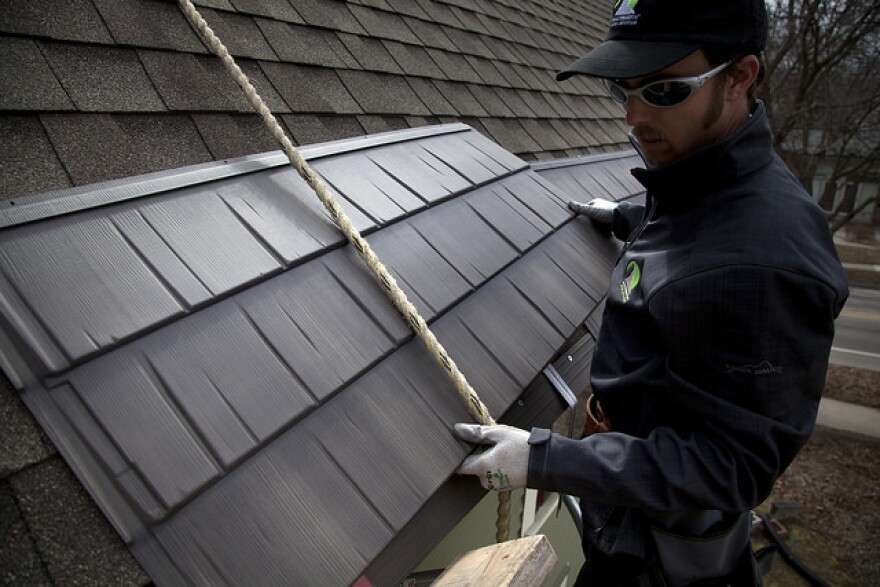There are lingering fears that nothing will be the same in Flint. But maybe things shouldn’t be the same. What if there is a better way for Flint and other cities to harvest and deliver life-enhancing water?
People across the nation are judging Flint as an epic failure of leadership and poor choices. There is no doubt that Flint’s water crisis is an unqualified failure of democracy, but it is also a century-old failure of design and systems thinking.
Providing safe, sustainable and equitable access to drinking water is a fundamental role of a democratic society and a basic human right. The moment has arrived for transformational thinking and profound policy changes, not a costly and bureaucratic rearranging of the deck chairs.
We need decentralized, integrated water management systems. Buildings, campuses and neighborhoods are all part of natural watersheds capable of harvesting water, managing stormwater and treating waste as a positive resource. Using simple, proven technologies and ecosystem sciences, Flint can become the world’s first Net Positive Water city.
We have a collective responsibility to question the underlying assumptions about repairing our failing centralized water infrastructure. The conventional wisdom is that the only way to solve the problem is to replace all the existing pipes with new ones. But why would we rebuild a system designed over a century ago that resulted in such cataclysmic failure?
Replacing every lead pipe or building a new pipeline from Lake Huron won’t solve the larger water problems faced by Flint.
Our policies and systems designs have not kept pace with our knowledge and scientific understanding. We need a new water ethic and an honest examination of our relationship with water.
Centralized water systems aren't natural
In nature, structurally diverse and complex systems are robust and healthy. Yet we continue to design our water systems with linear, oversimplified schemes not found anywhere in nature. In healthy watersheds there are no grids and no straight pipes.
Michigan’s aging water infrastructure -- like that of the rest of the U.S. -- fails at achieving healthy complexity found in natural systems. Rather, it is an overly-complicated Rube Goldberg contraption that lacks diversity and the resilience of a natural system, which makes it prone to catastrophic failure.
At its most basic, our outdated water infrastructure is a centralized three-pipe system. One pipe delivers intensively treated, potable water from a central plant to buildings.
We then take that clean water and pee in it, poop in it, bathe in it, water our lawns with it, wash our clothes with it, and put our tampons, industrial chemicals and prescription drugs in it.
After we pollute it, we discharge all of that toxic water back into a second pipe where it is sent to a goliath sewage treatment plant. This sewer line is filled with methane, hydrogen sulfide (sewer gas), unimaginable disease-causing organisms, commercial waste, food waste, FOG (the industry term for Fat, Oil and Grease), and many more unmentionables. From the sewage treatment plant, the water is released into the environment -- usually, but not always -- after the solid wastes have been removed.
In a tertiary pipe, we manage “stormwater,” but only after we mix it with toxic pollutants collected from our roofs, sidewalks, gutters and streets.
In nature, structurally diverse and complex systems are robust and healthy. Yet we continue to design our water systems with linear, oversimplified schemes not found anywhere in nature.
We used to call this water “rain.” It is a natural gift that comes to us free of cost. Yet, as we have expanded and strained our centralized infrastructures, we recast rainfall in apocalyptic terms. Rather than considering rainwater harvesting as an opportunity to cut out the middle man, we talk instead of solving the “problem” of stormwater management.
What we have is not working. So let’s start envisioning what a better system would look like.
So what's the Next Idea?
What if Flint could harvest from the sky all the water it needs? What if rather than turning ounces of clean water into gallons of toxic waste, every building managed its waste as elegantly as nature does?
We no longer need mega-projects to bring infrastructure to neighborhoods and buildings. The neighborhoods and buildings can be the infrastructure.
The University of Michigan BLUElab (Better Living Using Engineering) is using my family’s 115-year-old Victorian home as a living demonstration of the future of Net Positive Water. Using the strict standards of the Living Building Challenge, 100% of our home’s water needs will be supplied with captured precipitation and by recycling used household water, which will then be purified through a small treatment system without the use of chemicals. The students hope to inspire the next generation of water treatment, water reuse and waste management.
The Bullitt Center in Seattle is a six-story office building with an innovative approach to water. The building harvests rainwater to meet 100% of its water needs. Water is collected from the roof, stored in a 56,000 gallon cistern underground and then filtered and treated for potable use. The efficient use and reuse of water onsite allows the building to operate in a closed loop system, ensuring an endless supply of safe water.

The Bullitt Center and my home are among many pioneering Living Buildings offering Flint examples of reasonable alternatives to centralized infrastructure. These buildings are harvesting and treating water right where it is needed, demonstrating what is possible with proven off-the-shelf technologies.
One of the most inspiring Net Positive Water examples is the Omega Institute, in Rhinebeck, NY. A lush tropical garden of bananas and flowers grows in their Eco Machine treatment plant, which annually converts three million gallons of sewage into water clean enough to drink.
We are in a new era of high quality water treatment. There have been huge breakthroughs in membrane and ultraviolet (UV) filtration capable of treating rainwater that exceed EPA standards for municipal water.
Rain in Michigan is plentiful. It can be harvested, filtered, treated with UV light and provide all the fresh, clean water we need. Best of all, we don’t have to rely on centralized pipelines, treatment plants, or leaky and aging pipes (lead or otherwise) to deliver it to our homes. Rain can be harvested onsite or in our neighborhoods.
Building-scale systems can be installed in a few days. Neighborhood-scale systems could be installed in a matter of months or weeks. Site-based, human-centered design would allow Flint to bypass its broken grid of pipes. New technology created in drought-stricken regions would allow Flint to geo-spatially map its landscape to identify hidden hydrology to optimize capture, storage and treatment of rainwater. Armies of plumbers, volunteers and civil servants could install 10,000 systems in less than a year and immediately deliver permanent solutions to Flint families and business owners.
We must take a profound look into the design challenge of transitioning to a visible, bottom-up, complex adaptive water system. Flint has the chance to be the model for the next 100 years rather than repeating the mistakes of the last 100.
Nature doesn’t build grids. It assembles perpetually improving networks. Flint’s water system should reflect this wisdom. We have all the knowledge we need. Now it’s about will.
Matt Grocoff is principal of the THRIVE Collaborative and an advisor to the University of Michigan BLUElab Living Building Challenge Team.
Join the conversation in the comments section below, on Twitter or Facebook, or let us know your Next Idea here.




